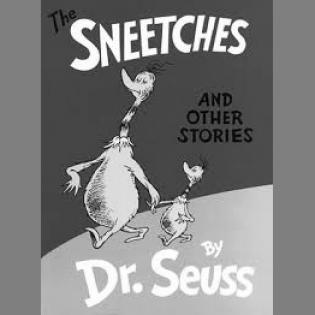The Sneetches Literature Guide
Although it is difficult to admit, we all are influenced by our prejudices. The more we are aware of our prejudices, the less harmful they are. This book by Dr. Seuss helps children see the silliness of judging people by their appearance rather than by their character. "Sneetches" encourages the reader to consider what it means to be fair and to treat people equitably.
Before Reading
ASK: Think about how people differ in your school or community. Think of attributes such as hair color, birth order in the family, favorite breakfast foods, shoe color, and clothing styles. Discuss whether these attributes make some people better or worse than others in the community. Tell the children that you are going to read a book in which these kinds of differences really do matter to the fictitious community.
SHOW: Look at a picture that contrasts the attitudes of the Star-Belly Sneetches with the Plain-Belly Sneetches. Notice how they both seem to feel about themselves.
CONNECT: Have you ever felt the way that the Star-Belly Sneetches seem to feel (proud, better than someone else). Have you ever felt the way the Plain-Belly Sneetches seem to feel (sad, left out, not as good)? Should physical differences determine how people are treated?
During Reading
ASK: Predict what may happen next when Mr. McBean, the star-remover, comes.
SHOW: Look at the picture of the Fix-it-Up Chappie driving away with their money. Discuss how the Sneetches must feel right then.
CONNECT: Talk about interesting words and stop and repeat phrases that are fun to say. Enjoy the language. The Fix-it-Up Chappie came to make money and laughed as he drove away. Do we ever spend money on foolish things?
After Reading
ASK: What lesson did the Sneetches learn? What will be different for them now? How much did it cost them? Was the cost too high or was it worth it?
SHOW: Look at the picture on the front cover. What would you change in the image to reflect how the Star-Belly Sneetches changed in the end? Should physical differences ever determine how people are treated? Why or why not?
CONNECT: Introduce and define the words prejudice and acceptance. The Star-Belly Sneetches showed prejudice against the Plain-Belly Sneetches when they could have shown acceptance for their differences. Discuss why it is important not to allow any form of prejudice in our family or community. What damage could it do? What are the benefits of treating everyone with fairness and respect?
Activities
- Discuss the importance of respect for others. How do people act toward one another if they have respect for each other? Write or illustrate a benefit of acceptance and treating others with respect.
- Learn more about how we can build communities that are more accepting with this Learning to Give toolkit on Equity and Justice.
- Draw two Seuss-like sets of unique creatures like the Sneetches. Give them names that include the attribute that makes them wonderfully unique. Draw them living in harmony.
